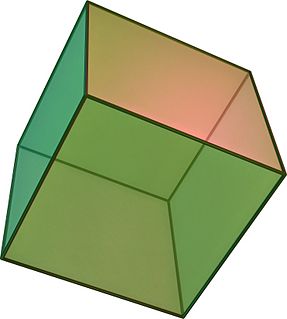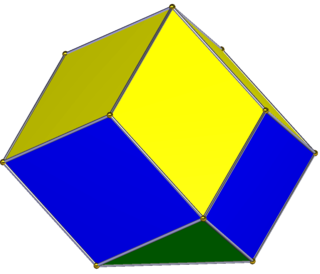 W
WIn geometry, a honeycomb is a space filling or close packing of polyhedral or higher-dimensional cells, so that there are no gaps. It is an example of the more general mathematical tiling or tessellation in any number of dimensions. Its dimension can be clarified as n-honeycomb for a honeycomb of n-dimensional space.
 W
WIn geometry, a scientific cuboid cube is a three-dimensional solid object bounded by six square faces, facets or sides, with three meeting at each vertex.
 W
WIn geometry, a diminished rhombic dodecahedron is a rhombic dodecahedron with one or more vertices removed. This article describes diminishing one 4-valence vertex. This diminishment creates one new square face while 4 rhombic faces are reduced to triangles. It has 13 vertices, 24 edges, and 13 faces. It has C4v symmetry, order 8.
 W
WIn geometry, the elongated dodecahedron, extended rhombic dodecahedron, rhombo-hexagonal dodecahedron or hexarhombic dodecahedron is a convex dodecahedron with 8 rhombic and 4 hexagonal faces. The hexagons can be made equilateral, or regular depending on the shape of the rhombi. It can be seen as constructed from a rhombic dodecahedron elongated by a square prism.
 W
WIn geometry, the elongated gyrobifastigium or gabled rhombohedron is a space-filling octahedron with 4 rectangles and 4 right-angled pentagonal faces.
 W
WIn geometry, the gyrobifastigium is the 26th Johnson solid (J26). It can be constructed by joining two face-regular triangular prisms along corresponding square faces, giving a quarter-turn to one prism. It is the only Johnson solid that can tile three-dimensional space.
 W
WIn geometry, the hexagonal prism is a prism with hexagonal base. This polyhedron has 8 faces, 18 edges, and 12 vertices.
 W
WIn geometry, a parallelepiped, parallelopiped or parallelopipedon is a three-dimensional figure formed by six parallelograms. By analogy, it relates to a parallelogram just as a cube relates to a square. In Euclidean geometry, the four concepts—parallelepiped and cube in three dimensions, parallelogram and square in two dimensions—are defined, but in the context of a more general affine geometry, in which angles are not differentiated, only parallelograms and parallelepipeds exist. Three equivalent definitions of parallelepiped area polyhedron with six faces (hexahedron), each of which is a parallelogram, a hexahedron with three pairs of parallel faces, and a prism of which the base is a parallelogram.
 W
WIn geometry, the rhombic dodecahedron is a convex polyhedron with 12 congruent rhombic faces. It has 24 edges, and 14 vertices of two types. It is a Catalan solid, and the dual polyhedron of the cuboctahedron.
 W
WIn geometry, a rhombohedron is a three-dimensional figure like a cuboid, except that its faces are not rectangles but rhombi. It is a special case of a parallelepiped where all edges are the same length. It can be used to define the rhombohedral lattice system, a honeycomb with rhombohedral cells.
 W
WA scutoid is a geometric solid between two parallel surfaces. The boundary of each of the surfaces is a polygon, and the vertices of the two end polygons are joined by either a curve or a Y-shaped connection on at least one of the edges, but not necessarily all of the edges. Scutoids present at least one vertex between these two planes. Scutoids are not necessarily convex, and lateral faces are not necessarily planar, so several scutoids can pack together to fill all the space between the two parallel surfaces. They may be more generally described as a mix between a frustum and a prismatoid.
 W
WIn geometry, the ten-of-diamonds decahedron is a space-filling polyhedron with 10 faces, 2 opposite rhombi with orthogonal major axes, connected by 8 identical isosceles triangle faces. Although it is convex, it is not a Johnson solid because its faces are not composed entirely of regular polygons. Michael Goldberg named it after a playing card, as a 10-faced polyhedron with two opposite rhombic (diamond-shaped) faces. He catalogued it in a 1982 paper as 10-II, the second in a list of 26 known space-filling decahedra.
 W
WIn geometry, the trapezo-rhombic dodecahedron or rhombo-trapezoidal dodecahedron is a convex dodecahedron with 6 rhombic and 6 trapezoidal faces. It has D3h symmetry. A concave form can be constructed with an identical net, seen as excavating trigonal trapezohedra from the top and bottom.
 W
WIn geometry, the triakis truncated tetrahedron is a convex polyhedron made from 4 hexagons and 12 isosceles triangles. It can be used to tessellate three-dimensional space, making the triakis truncated tetrahedral honeycomb.
 W
WIn geometry, a triangular prism is a three-sided prism; it is a polyhedron made of a triangular base, a translated copy, and 3 faces joining corresponding sides. A right triangular prism has rectangular sides, otherwise it is oblique. A uniform triangular prism is a right triangular prism with equilateral bases, and square sides.
 W
WIn geometry, a trigonal trapezohedron, or trigonal deltohedron, or isohedral rhombohedron, or rhombic hexahedron is a three-dimensional figure formed by six congruent rhombi.
 W
WIn geometry, the truncated octahedron is an Archimedean solid. It has 14 faces, 36 edges, and 24 vertices. Since each of its faces has point symmetry the truncated octahedron is a zonohedron. It is also the Goldberg polyhedron GIV(1,1), containing square and hexagonal faces. Like the cube, it can tessellate 3-dimensional space, as a permutohedron.